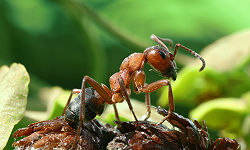Formica rufa
| Formica rufa | |
|---|---|
 |
|
| Formica rufa worker | |
| Scientific classification | |
| Kingdom: | Animalia |
| Phylum: | Arthropoda |
| Class: | Insecta |
| Order: | Hymenoptera |
| Family: | Formicidae |
| Subfamily: | Formicinae |
| Genus: | Formica |
| Species: | F. rufa |
| Binomial name | |
|
Formica rufa Linnaeus, 1761 |
|
Formica rufa, also known as the red wood ant, southern wood ant, or horse ant, is a boreal member of the Formica rufa group of ants, and is the type species for that group. It is native to Europe and Anatolia but is also found in North America, in both coniferous and broad-leaf broken woodland and parkland. Workers are bicolored red and brownish-black, with a dorsal dark patch on the head and promensonotum, and are polymorphic, measuring 4.5–9 mm in length. They have large mandibles and like many other ant species they are able to spray formic acid from their abdomens as a defence. Formic acid was first extracted in 1671 by the English naturalist John Ray by distilling a large number of crushed ants of this species.
Nests of these ants are large, conspicuous, dome-shaped mounds of grass, twigs, or conifer needles, often built against a rotting stump, usually situated in woodland clearings where the sun's rays can reach them. Large colonies may have 100,000 to 400,000 workers and 100 queens.F. rufa is highly polygynous and often readopts postnuptial queens from its own mother colony, leading to old, multigallery nests which may contain well over a hundred egg-producing females. These colonies can often measure several metres in height and diameter. F. rufa is aggressively territorial, and often attacks and removes other ant species from the area. Nuptial flights take place during the springtime and are often marked by savage battles between neighbouring colonies as territorial boundaries are re-established. New nests are established by budding from existing nests in the spring, or by the mechanism of temporary social parasitism, the hosts being species of the F. fusca group, notably F. fusca and F. lemani, although incipient F. rufa colonies have also been recorded from nests of F. glebaria, F. cunnicularia, and similar species including the Lasius genus. An F. rufa queen ousts the nest's existing queen, lays eggs, and the existing workers care for her offspring until the nest is taken over.
The ant's primary diet is aphid honeydew, but they also prey on invertebrates such as insects and arachnids; they are voracious scavengers. Foraging trails may extend 100 m. Larger workers have been observed to forage further away from the nest.F. rufa is commonly used in forestry and is often introduced into an area as a form of pest management.
...
Wikipedia

